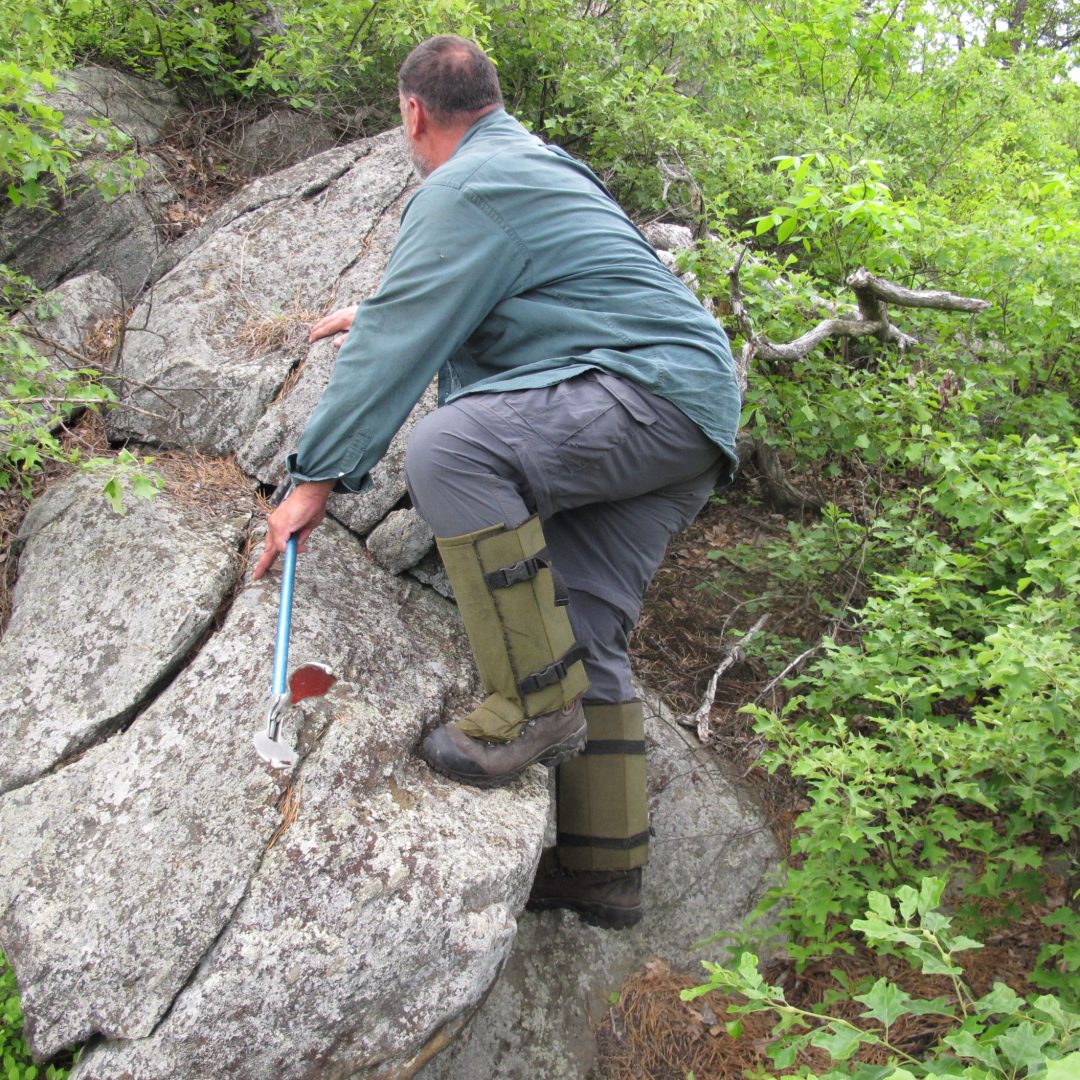Biologist Tom Tyning scrambles up a ledge in Massachusetts, looking for rattlesnakes he will study in his lab and then return to the wild. The snakes are rare because poachers steal them and sell them illegally. (Photo by Christine Woodside)
From Appalachia Winter/Spring 2019, published originally by the mountaineering and conservation journal of the Appalachian Mountain Club.
The rattlesnake, Crotalus horridus, is not cute. Poachers and scared people have nearly wiped them off the New England landscape in the last century or two. A few hundred years ago New England’s only venomous snake thrived. Streets, hills, and valleys are named after them. In my hometown of Deep River, Connecticut, Rattling Valley Road rambles down past outcroppings of ledge rock where, long ago, rattlesnakes lay on the cliffs. Back then you watched where you put your feet. Now cars ramble down that valley looking for a back way. A few dozen miles north of here, Rattlesnake Mountain houses television and cell antennae. Another Rattlesnake Mountain, free of snakes, overlooks Squam Lake in central New Hampshire; no snakes there, either. Rattlesnakes are so rare that biologists who study them won’t reveal the last few spots where they live lest they encourage poachers who usually know where they are, anyway.
For some years now, I’ve been on the trail of an underground rattlesnake poaching operation in New England. Snakes sell for hundreds of dollars on the internet, although harvesting and selling them in the Northeast is illegal. I set out to visit where they do thrive so that I could understand what drives small-time criminals to collect them in sacks and what fascinates those people who would buy a wild snake and keep it in a cage. And so I followed the only people who could legally show me: snake biologists.
—
Tom Tyning, a rattlesnake biologist from Berkshire Community College, panted as he trudged slowly up the steep side of a traprock ridge somewhere in southern Massachusetts—location to remain secret.
Tying has spent his life following snakes. As a kid he caught and kept snakes as if called by God. He told me that if he hadn’t picked the scientist route, he could have grown up to be a snake hunter—except that in the Northeast if you collect rattlesnakes without a scientist’s permit, you’re a poacher. Poachers have worked long careers with limited penalties. The most notorious of them was the late Rudy Komarek, who poached and killed 9,000 rattlesnakes in three states over 30 years. Komarek singlehandedly caused what researchers have called “the shocking demise” of rattlesnakes in Connecticut, New York, and Massachusetts. Tyning told me that after authorities caught and imprisoned Komarek, he remained unrepentant. From prison, as a protest, he mailed other illegal snake catchers maps marked in detail with places the rattlesnakes lived. Apparently it’s easy to help poachers from jail.
Komarek did the damage of several people. Today the secret Rudys are still at it. Tyning said, “There are always people getting arrested at airports who get caught with snakes in their pockets, tied to their legs. It’s become a really weird international ring of poaching. And it’s a huge smuggling operation. After birds and even before monkeys, reptiles, especially snakes, and turtles and lizards are among the biggest entities in international smuggling. They’re fascinating; they’re beautiful. I understand all that stuff.”
I had promised I would not say where I now trudged behind Tyning up a steep hill. The sun shone, which was vital to our quest. Sun brings out the snakes. As he panted up the ridge, Tyning joked that he was getting too old to chase his research subject. He was slightly overweight but very strong, and he pushed energetically toward the cliff where he knew a community of timber rattlesnakes lived. I would help him collect a few for his research. We were using all the same techniques poachers use. First, we would hike right to where he knew they would be basking. Then he would reach out with his snake tongs just as a snake went by. He would grab them with his snake tongs and drop them into a bag I would hold open. The bag looked like a pillowcase.
Late spring’s vegetal soil filled my nostrils. I heard a raspy hiss. A creature looking more like a black snake glided from under a rock. “Why does it look so dark?” I asked. Tyning said that sometimes their tan and black patterns seem to recede under grayish tones. “It’s about to shed its skin,” he told me. “Are you ready? I’m going to grab it, and you’re going to hold open the bag just when I tell you.”
“I’m ready,” I said, as if saying so would make it true. I had come out here out of respect and awe for an endangered reptile that could kill me with its bite. If it felt threatened, it could sink its fangs into my hovering arm. My skin would swell up and eventually turn black as the venom kills tissue so that it might be more easily digested were the snake to later make a meal of me. That would never happen. Snakes eat mice and other small rodents. They only bite humans if we threaten them. Which of course we were doing right then. Still, humans almost never die of rattlesnake bites, and antivenom available at nearby hospitals would reverse any bite’s damage quickly. I thought of none of that as I stood with the pillowcase, but Tyning’s calm demeanor washed over me.
“The fear of snakes,” a Minnesota snake information site explains, “is a learned behavior, which has been exacerbated by such things as myths and media misrepresentation.”
I would not fail Tyning; I would help him without causing new problems.
Road noise could not drown out the molting snake’s loud hissing. Tying leaned in, ready to strike with his grabber. I leaned in. He expertly affixed the two sides of the grabber around the snake. The rattling got louder.
The snake didn’t like what it knew was coming. It rattled and rattled; I felt rattled. Tyning reached out with his grabber—and the thing wouldn’t shut down. It was stuck open. The snake slid down and away and underneath another rock. That had never happened to this biologist in his entire career, and I was a witness. Something about the escape told me more than if we’d gotten the snake. I’d gotten very close and could see the beautiful shingles of its skin.
—
Dennis Quinn, an independent herpetologist, wore tan cargo pants and a green striped polo shirt. He might have been out for a ramble in the woods. Except he looked pretty odd. He was carrying a long snake grabber and he asked if I would take one side of a large plastic cooler. He joked that he dressed like a poacher—and that they tend to use the same collecting tactics. Quinn’s job that day was collecting snakes for a study of fungal disease. In a lab, scientists would take blood samples and make observations.
We trudged up and around a set of rock outcroppings covered by young tree growth. They were in there. We peered down. He gently poked a pole under the rock, just to rustle them up a bit. They slithered out like a slow, downhill seep. I stood by, thinking I ought to apologize. One short one I peered at from a crouch, watching his eyes, which looked like vertical slits. “Sorry, guy,” I murmured. Quinn turned to me, reassuringly, and said, “I’ll return these in a few days. Your job now is to open the cooler when I say.”
He grabbed first one, then another, then another snake with his tool and quickly placed them into giant pillowcases. These are the tools of the poacher. He said, without irony, that he guessed scientists gathering snakes for lab studies could easily become snake hunters if they didn’t have their work. The hissing went on and on as I held open the green plastic lid.
A few days later, as he promised, Quinn returned alone with the cooler and set his research subjects free. I imagined them sighing (or the serpentine equivalent of sighing) and making fast time back to their big ledge rock. I felt awe by now. I cared. Many people do care about rattlesnakes now. Connecticut’s wildlife biologist Jenny Dickson told me later that the days of hysteria and fear have passed. “The public is more understanding,” she said. “You’re going to get the occasional intentional killing of the snakes. But they’re probably going to think twice before they pick up the shovel and just randomly whack something.”
A few years ago I thought I might see what else I could learn about the poacher Rudy Komarek, so I sent an email to the office that had secretly investigated his crimes in New York State:
“Dear office of environmental crime,” my letter started awkwardly. “I am working on a story about rattlesnakes and their incredibly low numbers due to poaching. I would like to interview someone who can talk about the problem of poaching timber rattlesnakes and who was involved with Operation Shell Shock a few years ago. Please let me hear from you.”
I did not hear from them. I will venture a guess why. The battle goes on. Any publicity might expose the last of the dens. I know well that reticence to tell a writer about endangered snakes. Poaching continues by quiet, strong criminals wearing hiking shoes and carrying pillowcases. They know where the snakes live, and they sneak in, take them, sell them illegally, and go back for more.
Stealthy small-time poaching in southern New England and New York State threatens a species that has retreated in the parade of civilization. This tragedy continues silently. People have crushed their land and them, losing important predators of rodents and disease-carrying ticks. If I got my wish, and it were no longer rarer than a lightning strike to see one, I could then fear them, and even hate them. To save the timber rattlesnake, we must preserve or recreate the conditions that led to our fear and hate. And we must learn not to act upon that fear.

